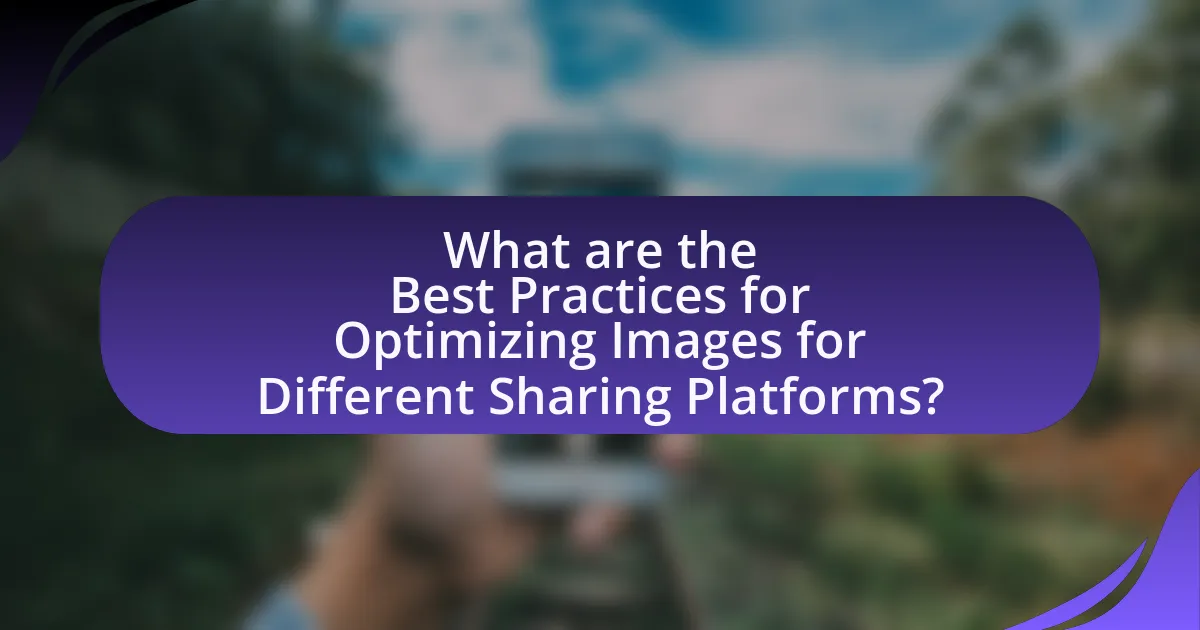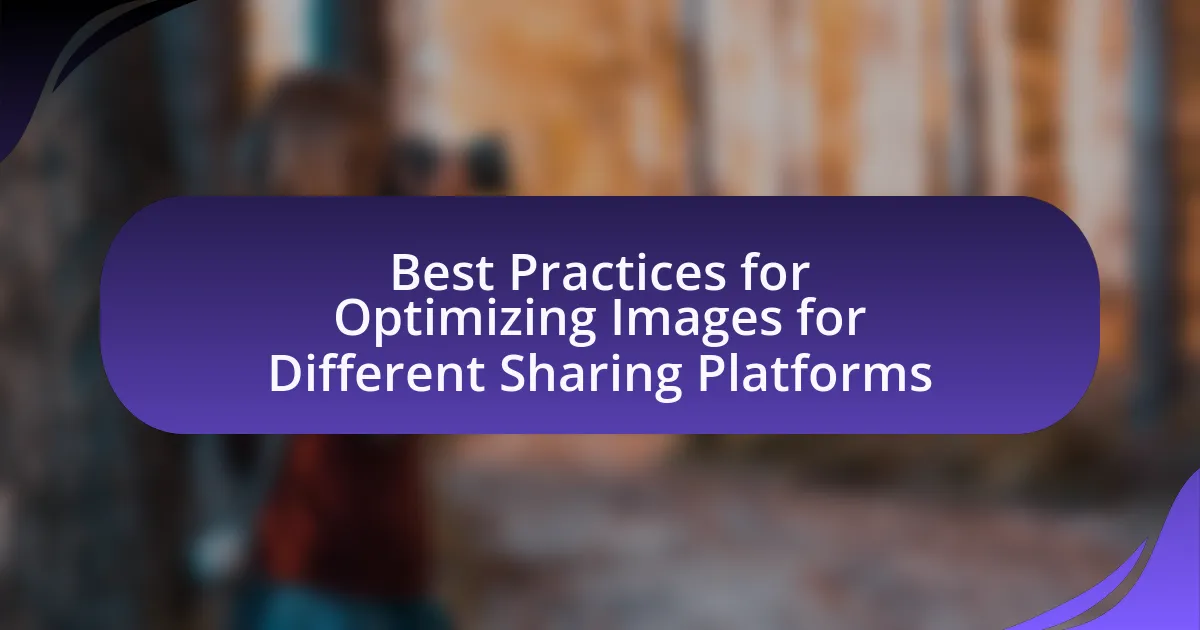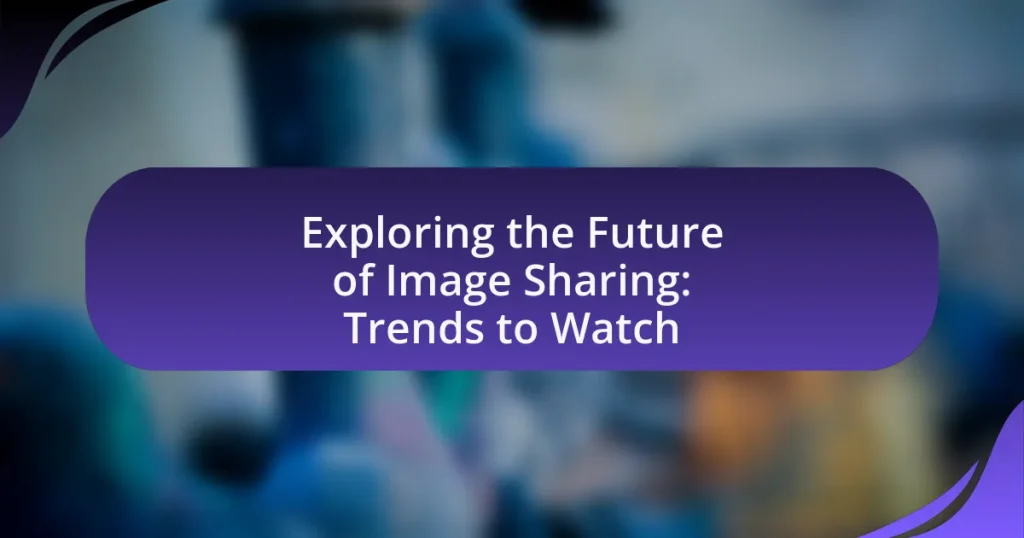The article focuses on best practices for optimizing images for various sharing platforms, emphasizing the importance of using correct dimensions, appropriate file formats, and effective compression techniques. It highlights how image optimization enhances loading speed, user engagement, and visibility on social media, with specific recommendations for image sizes on platforms like Facebook and Instagram. Additionally, the article discusses the impact of image quality on user interaction, the significance of adhering to platform-specific guidelines, and the latest trends in image optimization, including the use of AI tools and emerging technologies. Practical tips for effective image optimization are also provided, ensuring that images are visually appealing and accessible across different platforms.
What are the Best Practices for Optimizing Images for Different Sharing Platforms?

The best practices for optimizing images for different sharing platforms include using the correct dimensions, selecting appropriate file formats, and compressing images without losing quality. Each platform has specific recommended image sizes; for example, Facebook suggests 1200 x 630 pixels for shared images, while Instagram prefers 1080 x 1080 pixels for square posts. Choosing the right file format is crucial; JPEG is ideal for photographs due to its balance of quality and file size, while PNG is better for images requiring transparency. Additionally, compressing images using tools like TinyPNG can significantly reduce loading times, enhancing user experience and engagement. These practices ensure that images appear clear and professional across various platforms, ultimately improving visibility and interaction rates.
Why is Image Optimization Important for Social Media Sharing?
Image optimization is crucial for social media sharing because it enhances loading speed and improves user engagement. Optimized images reduce file size without sacrificing quality, leading to faster page loads, which is essential as studies show that a one-second delay in loading time can decrease user satisfaction by 16%. Additionally, platforms like Facebook and Instagram prioritize high-quality images in their algorithms, meaning optimized images are more likely to be displayed prominently, increasing visibility and interaction rates. Therefore, effective image optimization directly contributes to better performance and reach on social media platforms.
How does image quality impact user engagement on social platforms?
Image quality significantly impacts user engagement on social platforms by influencing how users perceive and interact with content. High-quality images attract more attention, leading to increased likes, shares, and comments. Research indicates that posts with high-resolution images receive 94% more views than those with lower quality. Additionally, a study by BuzzSumo found that articles featuring images with a resolution of 1200 x 630 pixels garnered 73% more social shares compared to those with lower resolution images. This correlation demonstrates that better image quality enhances user engagement, making it a crucial factor for content creators on social media.
What role does loading speed play in image optimization?
Loading speed is crucial in image optimization as it directly impacts user experience and search engine rankings. Faster loading images enhance website performance, leading to lower bounce rates and higher engagement. Studies show that a one-second delay in page load time can result in a 7% reduction in conversions, emphasizing the importance of optimizing image sizes and formats to improve loading speed. Additionally, search engines like Google consider loading speed as a ranking factor, making it essential for visibility in search results.
What Factors Should Be Considered When Optimizing Images?
When optimizing images, factors such as file format, resolution, compression, dimensions, and alt text should be considered. The choice of file format impacts quality and loading speed; for instance, JPEG is suitable for photographs, while PNG is better for images requiring transparency. Resolution affects clarity, with 72 DPI being standard for web use, while higher DPI is necessary for print. Compression reduces file size without significantly sacrificing quality, and tools like TinyPNG can help achieve this. Dimensions should match the display requirements of the platform to avoid unnecessary scaling. Lastly, alt text enhances accessibility and improves SEO, making it essential for image optimization.
How do image dimensions vary across different platforms?
Image dimensions vary significantly across different platforms, with each platform having its own recommended sizes for optimal display. For instance, Instagram typically favors square images at 1080 x 1080 pixels, while Facebook recommends a size of 1200 x 630 pixels for shared links. Twitter suggests images of 1200 x 675 pixels for tweets. These variations are essential for ensuring that images appear correctly and attractively on each platform, as using the recommended dimensions can enhance engagement and visibility.
What file formats are best for various sharing platforms?
JPEG is the best file format for sharing images on most platforms due to its balance of quality and file size. JPEG files are widely supported across social media, websites, and email, making them ideal for sharing. PNG is preferred for images requiring transparency and higher quality, such as logos and graphics, while GIF is suitable for simple animations. For high-quality images, especially in professional contexts, TIFF is recommended, although it has larger file sizes and limited compatibility. Each format serves specific needs, ensuring optimal presentation and performance on various platforms.
What Tools and Techniques Can Be Used for Image Optimization?
Image optimization can be effectively achieved using various tools and techniques. Tools such as Adobe Photoshop, TinyPNG, and ImageOptim allow users to compress images without significant loss of quality, which is crucial for faster loading times on websites. Techniques like resizing images to the appropriate dimensions, using the correct file formats (JPEG for photographs, PNG for graphics with transparency), and implementing lazy loading can further enhance performance. According to Google, optimizing images can improve page load speed by up to 80%, directly impacting user experience and SEO rankings.
Which software options are available for image compression?
Software options available for image compression include Adobe Photoshop, GIMP, TinyPNG, ImageOptim, and JPEGmini. Adobe Photoshop offers advanced features for image editing and compression, allowing users to save images in various formats with customizable quality settings. GIMP is a free, open-source alternative that provides similar capabilities for image manipulation and compression. TinyPNG is an online tool that specializes in compressing PNG and JPEG images while maintaining quality. ImageOptim is a Mac application that optimizes images by removing unnecessary metadata and compressing file sizes. JPEGmini focuses specifically on JPEG images, reducing file size significantly without noticeable loss in quality. These tools are widely recognized for their effectiveness in optimizing images for various sharing platforms.
How can online tools assist in optimizing images for sharing?
Online tools assist in optimizing images for sharing by providing features such as resizing, compression, and format conversion. These tools enable users to adjust image dimensions to meet platform-specific requirements, ensuring that images display correctly without excessive loading times. For instance, tools like TinyPNG and ImageOptim reduce file sizes significantly while maintaining quality, which is crucial for faster uploads and better user experience on social media. Additionally, many online tools offer batch processing capabilities, allowing users to optimize multiple images simultaneously, thus saving time and effort.
How Can You Ensure Consistency Across Different Platforms?
To ensure consistency across different platforms, standardize image dimensions, file formats, and color profiles. This approach guarantees that images appear uniform regardless of the platform used. For instance, using a common aspect ratio, such as 16:9, helps maintain visual integrity across social media and websites. Additionally, employing the sRGB color profile ensures that colors remain consistent across various devices and platforms, as this profile is widely supported. Research indicates that consistent branding, including visual elements, can enhance brand recognition by up to 80%, reinforcing the importance of maintaining uniformity across platforms.
What strategies help maintain brand identity through images?
Consistent use of color schemes, typography, and visual styles helps maintain brand identity through images. By adhering to a defined color palette and font choices, brands create a recognizable visual language that resonates with their audience. For instance, companies like Coca-Cola consistently use their signature red and white colors, reinforcing brand recognition across various platforms. Additionally, employing a cohesive style in imagery, such as photography or illustration techniques, ensures that all visual content aligns with the brand’s personality and values. This strategic approach not only enhances brand recall but also fosters trust and loyalty among consumers.
How can you adapt images for different audience preferences?
To adapt images for different audience preferences, tailor the visual content to align with the specific interests, cultural backgrounds, and emotional triggers of each audience segment. For instance, research indicates that color choices can significantly impact viewer perception; a study by the Institute for Color Research found that people make a subconscious judgment about a person, environment, or product within 90 seconds, with 62-90% of that assessment based on color alone. Therefore, using colors that resonate with the target demographic can enhance engagement. Additionally, incorporating culturally relevant symbols or themes can further increase relatability and connection. By analyzing audience data and preferences, marketers can create images that not only attract attention but also foster a deeper emotional response, leading to improved interaction and sharing across various platforms.
What Common Mistakes Should Be Avoided in Image Optimization?
Common mistakes to avoid in image optimization include using high-resolution images without compression, neglecting to use appropriate file formats, and failing to add alt text for accessibility. High-resolution images can significantly slow down page load times, negatively impacting user experience and SEO; for instance, images should ideally be compressed to reduce file size without sacrificing quality. Additionally, using the wrong file format, such as PNG for photographs instead of JPEG, can lead to unnecessarily large files. Lastly, omitting alt text not only hinders accessibility for visually impaired users but also limits search engine indexing, which can affect overall visibility.
How can over-compression affect image quality?
Over-compression significantly degrades image quality by introducing artifacts such as blurring, pixelation, and loss of detail. When an image is excessively compressed, the algorithm reduces file size by discarding important visual information, which can lead to noticeable distortions. For instance, JPEG compression, which is commonly used, can result in blockiness and color banding when the compression ratio is too high. Studies have shown that images compressed beyond a certain threshold can lose up to 50% of their perceptual quality, making them unsuitable for professional use or high-resolution displays.
What are the pitfalls of ignoring platform-specific guidelines?
Ignoring platform-specific guidelines can lead to significant issues such as poor user experience, reduced engagement, and potential content rejection. Each platform has unique specifications regarding image dimensions, file types, and aspect ratios that optimize visibility and interaction. For instance, images that do not meet the required dimensions may be cropped or distorted, negatively impacting the visual appeal and effectiveness of the content. Additionally, failure to adhere to guidelines can result in lower search rankings and decreased discoverability, as platforms prioritize content that aligns with their standards. This is evidenced by studies showing that posts with optimized images receive up to 94% more views compared to those that do not follow guidelines.
What Are the Latest Trends in Image Optimization for Social Media?
The latest trends in image optimization for social media include the use of AI-driven tools for automatic resizing and enhancement, the adoption of WebP format for faster loading times, and the emphasis on mobile-first design. AI tools streamline the process by analyzing images and adjusting them for optimal performance across various platforms, which is crucial as 80% of social media users access content via mobile devices. The WebP format, developed by Google, reduces file sizes without compromising quality, leading to improved loading speeds and user engagement. Additionally, brands are increasingly focusing on visually appealing content that aligns with platform-specific guidelines, enhancing visibility and interaction rates.
How is AI influencing image optimization practices?
AI is significantly influencing image optimization practices by automating the process of adjusting image quality, size, and format based on specific platform requirements. This automation allows for faster loading times and improved user experience across various sharing platforms. For instance, AI algorithms can analyze user engagement data to determine the optimal image dimensions and compression levels that enhance visibility and interaction. Additionally, tools like Adobe Photoshop and online services such as TinyPNG utilize AI to intelligently compress images without noticeable loss of quality, ensuring that images are optimized for both web and mobile environments.
What emerging technologies are shaping the future of image sharing?
Emerging technologies shaping the future of image sharing include artificial intelligence (AI), blockchain, and augmented reality (AR). AI enhances image recognition and personalization, allowing platforms to deliver tailored content to users, which increases engagement. Blockchain technology offers secure and transparent ownership verification, enabling artists and photographers to protect their work and monetize it effectively. AR provides immersive experiences, allowing users to interact with images in innovative ways, such as virtual try-ons or interactive storytelling. These technologies collectively transform how images are shared, consumed, and monetized across various platforms.
What Practical Tips Can Help You Optimize Images Effectively?
To optimize images effectively, use the following practical tips: compress images to reduce file size without sacrificing quality, utilize appropriate file formats such as JPEG for photographs and PNG for graphics with transparency, and ensure images are sized correctly for their intended platform to enhance loading speed and user experience. Research indicates that optimized images can improve website loading times by up to 70%, which directly impacts user engagement and SEO rankings. Additionally, implementing descriptive alt text enhances accessibility and can improve search engine visibility.



